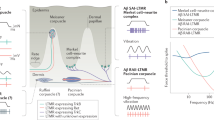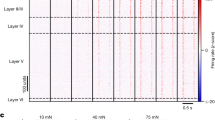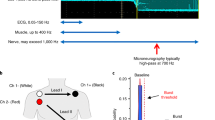Abstract
This protocol details methods to identify and record from cutaneous primary afferent axons in an isolated mammalian skin–saphenous nerve preparation. The method is based on extracellular recordings of propagated action potentials from single-fiber receptive fields. Cutaneous nerve endings show graded sensitivities to various stimulus modalities that are quantified by adequate and controlled stimulation of the superfused skin with heat, cold, touch, constant punctate pressure or chemicals. Responses recorded from single-fibers are comparable with those obtained in previous in vivo experiments on the same species. We describe the components and the setting-up of the basic equipment of a skin–nerve recording station (few days), the preparation of the skin and the adherent saphenous nerve in the mouse (15–45 min) and the isolation and recording of neurons (approximately 1–3 h per recording). In addition, stimulation techniques, protocols to achieve single-fiber recordings, issues of data acquisition and action potential discrimination are discussed in detail.
This is a preview of subscription content, access via your institution
Access options
Subscribe to this journal
Receive 12 print issues and online access
$259.00 per year
only $21.58 per issue
Buy this article
- Purchase on Springer Link
- Instant access to full article PDF
Prices may be subject to local taxes which are calculated during checkout


















Similar content being viewed by others
References
Nakai, J. Dissociated dorsal root ganglia in tissue culture. Am. J. Anat. 99, 81–129 (1956).
Murray, M.R. & Kopech, G. A Bibliography of the Research in Tissue Culture (Academic Press, New York, 1953).
Drew, L.J., Wood, J.N. & Cesare, P. Distinct mechanosensitive properties of capsaicin-sensitive and -insensitive sensory neurons. J. Neurosci. 22, RC228 (2002).
Cesare, P. & McNaughton, P. A novel heat-activated current in nociceptive neurons and its sensitization by bradykinin. Proc. Natl. Acad. Sci. USA 93, 15435–15439 (1996).
Reid, G. & Flonta, M.L. Physiology. Cold current in thermoreceptive neurons. Nature 413, 480 (2001).
Renganathan, M., Cummins, T.R. & Waxman, S.G. Contribution of Na(v)1.8 sodium channels to action potential electrogenesis in DRG neurons. J. Neurophysiol. 86, 629–640 (2001).
Wood, J.N. et al. Capsaicin-induced ion fluxes in dorsal root ganglion cells in culture. J. Neurosci. 8, 3208–3220 (1988).
Wood, J.N., Boorman, J.P., Okuse, K. & Baker, M.D. Voltage-gated sodium channels and pain pathways. J. Neurobiol. 61, 55–71 (2004).
Bhave, G. & Gereau, R.W. Posttranslational mechanisms of peripheral sensitization. J. Neurobiol. 61, 88–106 (2004).
Caterina, M.J. et al. The capsaicin receptor: a heat-activated ion channel in the pain pathway. Nature 389, 816–824 (1997).
Woodbury, C.J. et al. Nociceptors lacking TRPV1 and TRPV2 have normal heat responses. J. Neurosci. 24, 6410–6415 (2004).
Zimmermann, K. et al. The TRPV1/2/3 activator 2-aminoethoxydiphenyl borate sensitizes native nociceptive neurons to heat in wildtype but not TRPV1 deficient mice. Neuroscience 135, 1277–1284 (2005).
Akopian, A.N., Sivilotti, L. & Wood, J.N. A tetrodotoxin-resistant voltage-gated sodium channel expressed by sensory neurons. Nature 379, 257–262 (1996).
Akopian, A.N. et al. The tetrodotoxin-resistant sodium channel SNS has a specialized function in pain pathways. Nat. Neurosci. 2, 541–548 (1999).
Zimmermann, K. et al. Sensory neuron sodium channel Nav1.8 is essential for pain at low temperatures. Nature 447, 856–859 (2007).
Matsutomi, T., Nakamoto, C., Zheng, T., Kakimura, J. & Ogata, N. Multiple types of Na(+) currents mediate action potential electrogenesis in small neurons of mouse dorsal root ganglia. Pflügers Arch. 453, 83–96 (2006).
Bessou, P. & Perl, E.R. Response of cutaneous sensory units with unmyelinated fibers to noxious stimuli. J. Neurophysiol. 32, 1025–1043 (1969).
Hensel, H. & Zotterman, Y. The effect of menthol on the thermoreceptors. Acta. Physiol. Scand. 24, 27–34 (1951).
Hensel, H. & Zotterman, Y. The response of mechanoreceptors to thermal stimulation. J. Physiol 115, 16–24 (1951).
Hensel, H. & Zotterman, Y. The response of the cold receptors to constant cooling. Acta. Physiol. Scand. 22, 96–105 (1951).
Zotterman, Y. Touch, pain and tickling: an electro-physiological investigation on cutaneous sensory nerves. J. Physiol. 95, 1–28 (1939).
Hensel, H. & Kenshalo, D.R. Warm receptors in the nasal region of cats. J. Physiol. 204, 99–112 (1969).
Hensel, H. & Huopaniemi, T. Static and dynamic properties of warm fibres in the infraorbital nerve. Pflügers Arch. 309, 1–10 (1969).
Bessou, P., Burgess, P.R., Perl, E.R. & Taylor, C.B. Dynamic properties of mechanoreceptors with unmyelinated (C) fibers. J. Neurophysiol. 34, 116–131 (1971).
Catton, W.T. Some properties of frog skin mechanoreceptors. J. Physiol. 141, 305–322 (1958).
Catton, W.T. Responses of frog skin to local mechanical stimulation. J. Physiol. 137, 81–2P (1957).
Gonzalez, C., Sanchez, J. & Concha, J. Changes in potential difference and short-circuit current produced by electrical stimulation in a nerve–skin preparation of the toad. Biochim. Biophys. Acta. 120, 186–188 (1966).
Diamond, J., Holmes, M. & Nurse, C.A. Are Merkel cell-neurite reciprocal synapses involved in the initiation of tactile responses in salamander skin? J. Physiol. 376, 101–120 (1986).
Weston, K.M., Foster, R.W. & Weston, A.H. The application of irritant chemicals selectively to the skin of the leech ganglion/body wall preparation. J. Pharmacol. Methods 12, 285–297 (1984).
Wedekind, C. Receptive properties of primary afferent fibres from rabbit pleura, in vitro . Somatosens. Mot. Res. 14, 229–236 (1997).
Kumazawa, T., Mizumura, K. & Sato, J. Response properties of polymodal receptors studied using in vitro testis superior spermatic nerve preparations of dogs. J. Neurophysiol. 57, 702–711 (1987).
Wenk, H.N. & McCleskey, E.W. A novel mouse skeletal muscle–nerve preparation and in vitro model of ischemia. J. Neurosci. Methods 159, 244–251 (2007).
Taguchi, T., Sato, J. & Mizumura, K. Augmented mechanical response of muscle thin-fiber sensory receptors recorded from rat muscle–nerve preparations in vitro after eccentric contraction. J. Neurophysiol. 94, 2822–2831 (2005).
Taguchi, T., Matsuda, T., Tamura, R., Sato, J. & Mizumura, K. Muscular mechanical hyperalgesia revealed by behavioural pain test and c-Fos expression in the spinal dorsal horn after eccentric contraction in rats. J. Physiol. 564, 259–268 (2005).
Lennerz, J.K. et al. Electrophysiological characterisation of vagal afferents relevant to mucosal nociception in the rat upper oesophagus. J. Physiol. 582, 229–242 (2007).
Yu, S., Undem, B.J. & Kollarik, M. Vagal afferent nerves with nociceptive properties in guinea-pig oesophagus. J. Physiol. 563, 831–842 (2005).
Juan, H. & Lembeck, F. Inhibition of the action of bradykinin and acetylcholine on paravascular pain receptors by tetrodotoxin and procaine. Naunyn. Schmiedebergs Arch. Pharmacol. 290, 389–395 (1975).
Juan, H. & Lembeck, F. Action of peptides and other algesic agents on paravascular pain receptors of the isolated perfused rabbit ear. Naunyn. Schmiedebergs Arch. Pharmacol. 283, 151–164 (1974).
Brock, J.A., McLachlan, E.M. & Belmonte, C. Tetrodotoxin-resistant impulses in single nociceptor nerve terminals in guinea-pig cornea. J. Physiol. 512, 211–217 (1998).
Carr, R.W., Pianova, S. & Brock, J.A. The effects of polarizing current on nerve terminal impulses recorded from polymodal and cold receptors in the guinea-pig cornea. J. Gen. Physiol. 120, 395–405 (2002).
Carr, R.W. et al. Effects of heating and cooling on nerve terminal impulses recorded from cold-sensitive receptors in the guinea-pig cornea. J. Gen. Physiol. 121, 427–439 (2003).
Carr, R.W. & Brock, J.A. Electrophysiology of corneal cold receptor nerve terminals. Adv. Exp. Med. Biol. 508, 19–23 (2002).
Madrid, R. et al. Contribution of TRPM8 channels to cold transduction in primary sensory neurons and peripheral nerve terminals. J. Neurosci. 26, 12512–12525 (2006).
Elitt, C.M. et al. Artemin overexpression in skin enhances expression of TRPV1 and TRPA1 in cutaneous sensory neurons and leads to behavioral sensitivity to heat and cold. J. Neurosci. 26, 8578–8587 (2006).
Koerber, H.R. & Woodbury, C.J. Comprehensive phenotyping of sensory neurons using an ex vivo somatosensory system. Physiol. Behav. 77, 589–594 (2002).
Reeh, P.W. Sensory receptors in mammalian skin in an in vitro preparation. Neurosci. Lett. 66, 141–146 (1986).
Cain, D.M., Khasabov, S.G. & Simone, D.A. Response properties of mechanoreceptors and nociceptors in mouse glabrous skin: an in vivo study. J. Neurophysiol. 85, 1561–1574 (2001).
Reeh, P.W. Sensory receptors in a mammalian skin–nerve in vitro preparation. Prog. Brain Res. 74, 271–276 (1988).
Mogil, J.S. et al. Variable sensitivity to noxious heat is mediated by differential expression of the CGRP gene. Proc. Natl. Acad. Sci. USA 102, 12938–12943 (2005).
Bernardini, N. et al. Muscarinic M2 receptors on peripheral nerve endings: a molecular target of antinociception. J. Neurosci. 22, RC229 (2002).
Kress, M., Petersen, M. & Reeh, P.W. Methylene blue induces ongoing activity in rat cutaneous primary afferents and depolarization of DRG neurons via a photosensitive mechanism. Naunyn. Schmiedebergs Arch. Pharmacol. 356, 619–625 (1997).
Kress, M., Riedl, B. & Reeh, P.W. Effects of oxygen radicals on nociceptive afferents in the rat skin in vitro . Pain 62, 87–94 (1995).
Kress, M. & Reeh, P.W. Chemical excitation and sensitization in nociceptors. In Neurobiology of Nociceptors (eds. Belmonte, C. & Cervero, F.) 258–297 (Oxford University, Oxford, 1996).
Petho, G., Derow, A. & Reeh, P.W. Bradykinin-induced nociceptor sensitization to heat is mediated by cyclooxygenase products in isolated rat skin. Eur. J. Neurosci. 14, 210–218 (2001).
Reeh, P.W. & Petho, G. Nociceptor excitation by thermal sensitization—a hypothesis. Prog. Brain Res. 129, 39–50 (2000).
Ringkamp, M. et al. Activated human platelets in plasma excite nociceptors in rat skin, in vitro . Neurosci. Lett. 170, 103–106 (1994).
Steen, K.H., Wegner, H. & Reeh, P.W. The pH response of rat cutaneous nociceptors correlates with extracellular [Na+] and is increased under amiloride. Eur. J. Neurosci. 11, 2783–2792 (1999).
Steen, K.H., Steen, A.E. & Reeh, P.W. A dominant role of acid pH in inflammatory excitation and sensitization of nociceptors in rat skin, in vitro . J. Neurosci. 15, 3982–3989 (1995).
Alloui, A. et al. TREK-1, a K+ channel involved in polymodal pain perception. EMBO J. 25, 2368–2376 (2006).
Kirchhoff, C., Jung, S., Reeh, P.W. & Handwerker, H.O. Carrageenan inflammation increases bradykinin sensitivity of rat cutaneous nociceptors. Neurosci. Lett. 111, 206–210 (1990).
Koltzenburg, M., Kress, M. & Reeh, P.W. The nociceptor sensitization by bradykinin does not depend on sympathetic neurons. Neuroscience 46, 465–473 (1992).
Bretag, A.H. Synthetic interstitial fluid for isolated mammalian tissue. Life Sci. 8, 319–329 (1969).
Schlegel, T., Sauer, S.K., Handwerker, H.O. & Reeh, P.W. Responsiveness of C-fiber nociceptors to punctate force-controlled stimuli in isolated rat skin: lack of modulation by inflammatory mediators and flurbiprofen. Neurosci. Lett. 361, 163–167 (2004).
Benedikt, J., Teisinger, J., Vyklicky, L. & Vlachova, V. Ethanol inhibits cold-menthol receptor TRPM8 by modulating its interaction with membrane phosphatidylinositol 4,5-bisphosphate. J. Neurochem. 100, 211–224 (2007).
Handwerker, H.O., Anton, F., Kocher, L. & Reeh, P.W. Nociceptor functions in intact skin and in neurogenic or non-neurogenic inflammation. Acta. Physiol. Hung. 69, 333–342 (1987).
Kocher, L., Anton, F., Reeh, P.W. & Handwerker, H.O. The effect of carrageenan-induced inflammation on the sensitivity of unmyelinated skin nociceptors in the rat. Pain 29, 363–373 (1987).
Lyfenko, A. et al. The effects of excessive heat on heat-activated membrane currents in cultured dorsal root ganglia neurons from neonatal rat. Pain 95, 207–214 (2002).
Liang, Y.F., Haake, B. & Reeh, P.W. Sustained sensitization and recruitment of rat cutaneous nociceptors by bradykinin and a novel theory of its excitatory action. J. Physiol. 532, 229–239 (2001).
Bade, H., Braun, H.A. & Hensel, H. Parameters of the static burst discharge of lingual cold receptors in the cat. Pflügers Arch. 382, 1–5 (1979).
Duclaux, R., Schafer, K. & Hensel, H. Response of cold receptors to low skin temperatures in nose of the cat. J. Neurophysiol. 43, 1571–1577 (1980).
Hensel, H. & Schafer, K. Static an dynamic activity of cold receptors in cats after long-term exposure to various temperatures. Pflügers Arch. 392, 291–294 (1982).
Hensel, H. Static and dynamic activity of warm receptors in Boa constrictor. Pflügers Arch. 353, 191–199 (1975).
Kress, M., Koltzenburg, M., Reeh, P.W. & Handwerker, H.O. Responsiveness and functional attributes of electrically localized terminals of cutaneous C-fibers in vivo and in vitro . J. Neurophysiol. 68, 581–595 (1992).
McKemy, D.D., Neuhausser, W.M. & Julius, D. Identification of a cold receptor reveals a general role for TRP channels in thermosensation. Nature 416, 52–58 (2002).
Colburn, R.W. et al. Attenuated cold sensitivity in TRPM8 null mice. Neuron 54, 379–386 (2007).
Dhaka, A. et al. TRPM8 is required for cold sensation in mice. Neuron 54, 371–378 (2007).
Kang, D., Choe, C. & Kim, D. Thermosensitivity of the two-pore domain K+ channels TREK-2 and TRAAK. J. Physiol. 564, 103–116 (2005).
Pethö, G., Izydorczyk, I. & Reeh, P.W. Effects of TRPV1 receptor antagonists on stimulated iCGRP release from isolated skin of rats and TRPV1 mutant mice. Pain 109, 284–290 (2004).
Koltzenburg, M., Stucky, C.L. & Lewin, G.R. Receptive properties of mouse sensory neurons innervating hairy skin. J. Neurophysiol. 78, 1841–1850 (1997).
Forster, C. & Handwerker, H.O. Automatic classification and analysis of microneurographic spike data using a PC/AT. J. Neurosci. Methods 31, 109–118 (1990).
Turnquist, B., Leverentz, M. & Swanson, E. Neural spike classification using parallel selection of all algorithm parameters. J. Neurosci. Methods 137, 291–298 (2004).
Cook, M.J. The Anatomy of the Laboratory Mouse (Academic Press Inc., New York, 1965).
Mogil, J.S. & Adhikari, S.M. Hot and cold nociception are genetically correlated. J. Neurosci. 19, RC25 (1999).
Munns, C., AlQatari, M. & Koltzenburg, M. Many cold sensitive peripheral neurons of the mouse do not express TRPM8 or TRPA1. Cell Calcium 41, 331–342 (2007).
Acknowledgements
We thank Richard Lewis (Department of Molecular Pharmacology, Institute for Molecular Bioscience, University of Queensland, Brisbane, Australia) and Richard Koerber (Department of Neurobiology, University of Pittsburgh, School of Medicine, Pittsburgh, PA, USA) for critical comments on the manuscript. This work was supported by the European Union (EU) and K.Z. was supported by the Deutsche Forschungsgemeinschaft (DFG).
Author information
Authors and Affiliations
Corresponding authors
Rights and permissions
About this article
Cite this article
Zimmermann, K., Hein, A., Hager, U. et al. Phenotyping sensory nerve endings in vitro in the mouse. Nat Protoc 4, 174–196 (2009). https://doi.org/10.1038/nprot.2008.223
Published:
Issue Date:
DOI: https://doi.org/10.1038/nprot.2008.223
This article is cited by
-
Electrophysiological characterization of ectopic spontaneous discharge in axotomized and intact fibers upon nerve transection: a role in spontaneous pain?
Pflügers Archiv - European Journal of Physiology (2022)
-
Responses of cutaneous C-fiber afferents and spinal microglia after hindlimb cast immobilization in rats
The Journal of Physiological Sciences (2021)
-
An artificial neural tactile sensing system
Nature Electronics (2021)
-
Elevated dietary ω-6 polyunsaturated fatty acids induce reversible peripheral nerve dysfunction that exacerbates comorbid pain conditions
Nature Metabolism (2021)
-
Depiction of Oral Tumor-Induced Trigeminal Afferent Responses Using Single-Fiber Electrophysiology
Scientific Reports (2019)
Comments
By submitting a comment you agree to abide by our Terms and Community Guidelines. If you find something abusive or that does not comply with our terms or guidelines please flag it as inappropriate.



